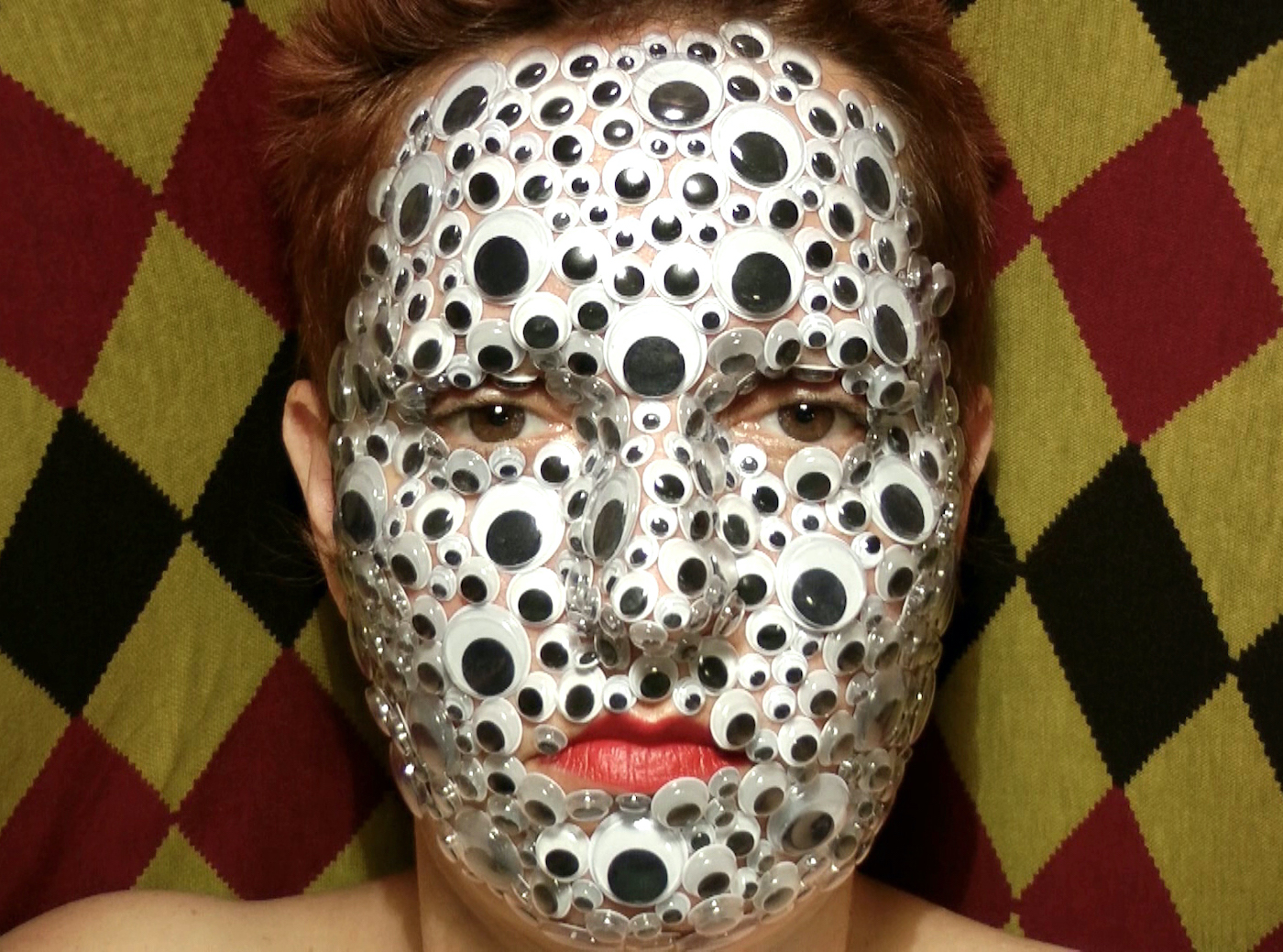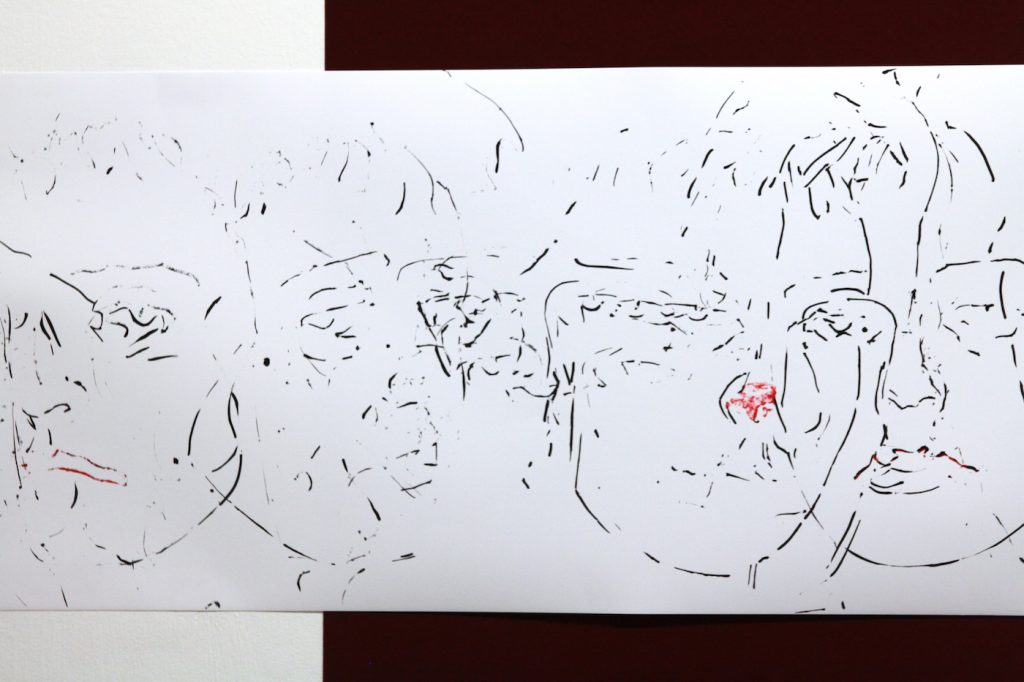Creative Characters: Sally Krysztal Kramberg

Some people run off to the circus, other people study the circus and form an entire exhibit around it. In her showcase Charivari, on display at the Santa Barbara Center for Art, Science, and Technology (SBCAST), multidisciplinary artist Sally Krysztal Kramberg explores the different circus archetypes, placing herself in these roles to discover her self-identity and define her life as an immigrant.
Currently based in Tel Aviv, Sally comes from a legacy of immigrants. During WWII, her parents, both Jewish and being children at the time, had to be hidden around France during the Nazi occupation. Although Sally was born in France, her family moved to Israel when she was a child. This was around 1975 and since it was a young, growing nation, there was a push to erase past identities, with less patience for being an individual and a greater focus on establishing a group identity. Her family spoke French at home and followed the French way of life, often leaving to feelings of isolation at school and with friends.
When she began attending art school, she was encouraged to develop her individual identity, and this newfound voice led to a direction in her work. Her first art show focused on this internal conflict between self-identity and the desire for group acceptance and conformity. The exhibit was of a school corridor that featured different class photos composed completely of her self-portrait, modified and repeated to form the entire school population. If the group and the individual are one, then there is continuity between who the individual wants to be and how the group accepts said person.
Sally had been fascinated with the circus since she was a child. As she began to research the history of the circus, she began to see similarities between immigrants and circus folk. Both live a gypsy-like existence with home being defined, not by a single location, but formed where they can find it, and community coming from those with whom they travel. Historically, these circus and sideshow exhibitions offered the performers a chance for pride, fame, and the opportunity to travel the world. Sally appreciated that circus performers all had their glory moments on stage but would also work together behind the scenes to help the circus run. For Sally, she is the circus and these different personified characters explore different parts of her self while working together to put on a complete show.
In the circus, “charivari” is the historical name for the noisy intermission wherein clowns would come out banging instruments, jumping around the audience, and just making a general clamor. The charivari actually served a second purpose. It would help distract the audience as the next act was being set up. Despite the noisy display and flamboyant external appearance, the charivari was not the real show, it was merely a distraction. The exhibit Charivari fills two galleries at SBCAST and explores different personifications of various circus archetypes and spectators.
Circus performers have a limited time on the stage. The circus can be unforgiving once a performer is used up or past his or her prime. For Charivari, Sally wanted to focus on using materials that were fragile and had a limited life span. In the circus, a “fakir” was the performer who would dazzle audiences with feats such as fire eating and lying on a bed of a nails. In her personification of a fakir, Sally wanted to create one who had just come off of a bed of nails but had lost skin in the process.
For The Fakir, she outlined her form on paper, filling the shape by cutting countless slits that give the appearance of the snake skin. She then pulled the body from the paper, laying it crumpled on the floor as if it were shed skin. The Acrobat is the sister piece to this one and is composed of a fragile, embossed parchment paper. The acrobat has missed her mark, laying on top of a figurative netting and looking helpless with her limbs curled and distorted.

One of the main pieces is Effacé, which forms an audience of “flats,” the term that the trapeze and aerial artist would call the audience, since they would appear flat from that distance. This paper scroll lines the wall with Sally repeating and modifying her self portrait along the paper to form an audience that both watches the various circus performers and the viewer as they watch the exhibit.
In the various pieces of Charivari, many of the performers display signs of strain in their relationship with the audience. With Sally’s own face composing the demanding crowd and her self also filling the role of the performer, Sally explores the expectations we place on ourselves and the role that ego plays in representing our external self. Which performer does our ego display and how does the self respond to it? We all have this relationship between being the performer and the audience when discovering our own identity.
Although Sally has a background in photography and crafts, her works are multidisciplinary and she jokes that she will work with “everything but painting.” In addition to the mixed-media pieces on the walls, there are three video installations of her representing different characters.
The Bear features a video of Sally in a bear mask that she crafted. The bear is the oldest member of her circus; he lazily looks up at the viewer before falling back asleep. When first developing the installation, she began with taking photos of her in the mask. The images looked flat and she was displeased with the effect. She wore the mask for two weeks in her studio to further develop the character. When she filmed herself in character, she found that the video format had more of the structure and expression she was looking for and decided to represent the characters in film rather than print.
The Reptile Man features her face, completely covered in googly eyes. The Reptile Man looks into the camera, occasionally shaking his head furiously to create a fierce rattling sound, giving off a warning and once again placing an attentive focus on the viewer. In The Knife Thrower’s Assistant, a video shows her single breast exposed as she repeatedly smacks sticker knives into it.
Often in the circus, Sally found that the female assistant was there to provide no special talent. She was usually married to the knife thrower or magician and essentially just served as eye candy and a distraction during the performance and the husband performer’s caretaker after it. In this version, the assistant has taken her identity into her own hands in an act of self-mutilation.
Charivari is a larger part of the three-gallery exhibition 70.70.70. that is currently taking place around town. 70.70.70., sponsored by the Squire Foundation, was curated by Lynn M. Holley and Sagi Refael and designed to celebrate the 70th anniversary of the State of Israel (formed on May 14, 1948) with works by 70 Israeli artists on display for 70 days. Charivari will be up at SBCAST until Sunday, May 13. Sally will be hosting an artist lecture on Tuesday, May 8, from 5 to 6 pm and a performance on that Saturday, May 12, from 6 to 7 pm. After Charivari, the second half of May at SBCAST will feature Israeli metal and welding artist Hila Laiser-Beja until Tuesday, May 29.
In addition to the shows at SBCAST, the Bronfman Family Jewish Community Center (524 Chapala St.) is displaying multiple works by a selection of Israeli artists through Tuesday, May 8. The Grayspace Gallery (219 Gray Ave.) will be featuring three Israeli artists and local artist Margaret Singer until Sunday, May 13.
If you would like to see more of Sally’s work, visit sallykrysztal.com to see her other exhibits and performances.





